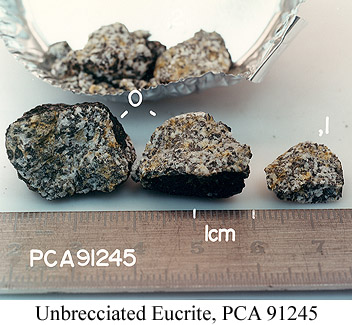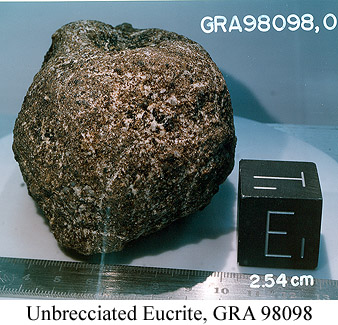Kevin Righter, NASA-JSC New Meteorites
This newsletter contains classifications for 274 new meteorites from the 2003 and 2004 ANSMET collections. They include samples from the Cumulus Hills, Larkman Nunatak, LaPaz Ice Field, MacAlpine Hills, Dominion Range, Miller Range, Roberts Massif, and Sandford Cliffs. Petrographic descriptions are given for 33 of the new meteorites; 19 pallasites, 2 ureilites, 1 anomalous ureilite, 1 unusual aubrite, a mesosiderite clast, 1 unbrecciated eucrite, 2 CK, 2 CM, and 1 CO3 chondrites, 2 type 3 ordinary chondrites, and a small iron. Several of these new meteorites are paired with samples from previous newsletters (see Table 3). The two new CK chondrites bring the number of US Antarctic CK's to a total of 77 (20 unique meteorites with pairings).
Pallasites are rare among Antarctica meteorites. Previously there have been only 8 recovered: PCA 91004, PCA 91005, PCA 91388, QUE 93544 (ANSMET), GRV 020099 (PRIC collection), Thiel Mountains (main mass at NMNH) and Y74044, and Y8451 (NIPR collection). CMS 04069 (44.7 kg) and its 18 pairs from Cumulus Hills total 170.55 kg, by far the largest pallasite yet recovered from Antarctica.
CMS 04049 is a beautiful unbrecciated eucrite. Its coarse grained nature is similar to a few other unbrecciated eucrites in the collection, including PCA 91245 and GRA 98098. Pictures of each of these have recently been added to our website at http://sn-charon.jsc.nasa.gov/DBSearch/AntMet/MetClass-Form.asp, and are shown below for comparison to the images of the new sample, CMS 04049. Finally, we have two very unusual achondrites in the newsletter. LAR 04315 is an anomalous ureilite that contains many interesting features described within by Tim McCoy, and LAR 04316 is an aubrite that contains a rare basaltic vitrophyre clast similar to those described by Fogel (GCA 69, 1633-1648) in Khor Temiki and LEW 87007.


Requesting Samples
In light of several requests we have received, we have decided to reiterate a few points when writing sample requests. First, the Meteorite Working Group (MWG) meets twice a year to make recommendations regarding requests for scientific study of meteorites. The MWG members can most effectively judge the merits of a study when the descriptions are concise yet informative. For example, when someone states "I need this meteorite for my research", that is not very helpful, because the research is not mentioned, nor is the reason given for the need. Please give a brief description of the research, along with an explanation of why these particular samples are of interest. Second, sometimes we receive multiple requests from one investigator for the same deadline. Although we realize that sometimes this is unavoidable, please try to keep all requests on one form.
Lunar Meteorite Compendium
Work is continuing on the Lunar Meteorite Compendium. Draft chapters have been completed for six of the US Antarctic meteorites - ALHA81005 (the first recognized lunar meteorite), MAC 88105, LAP 02205 (and their pairings) QUE 93069/94269, QUE 94281, and EET 87521/96008. Processing sketches and genealogy charts have been prepared for these meteorites, and will soon be posted on our website. In addition, chapters are underway for the other lunar meteorites in our collections -MET 01210 and PCA 02007, as well as others such a Y86032 and it's paired masses (Y82192 and 82193). In the meantime if you have some lunar meteorite publications that you think may be relevant to such a project, please send them to kevin.righter-1@nasa.gov. A few of you have done this already, and it has been very beneficial - thank you!
Ralph Harvey, Principal Investigator
Antarctic Search for Meteorites (ANSMET) program
In about 8 weeks we're going to be starting a new ANSMET season that promises to be one of the most challenging and potentially rewarding in a long time. But because of problems getting funding delivered and people put in the right places at the right times, preparations haven't been where they should be and there's still too much left to do. Only in the last few days has it been clear how many field parties we'd have, and field team membership is still in flux.
As in recent past seasons, ANSMET will send out two field parties. The first, a party of eight, will deploy to the Miller Range to begin systematic searching of the ice fields. This place has a lot of potential. It's been visited three times before, and each time field party members found meteorites in their path no matter the direction they were traveling. It's also where ANSMET found its most recent martian meteorite, the nakhlite MIL 03346, during a reconnaissance visit in 2003. I can't wait to see what else is out there!
The second team, dedicated to reconnaissance, has what can only be described as a "Groovy Retro-style" trip ahead of them (and here I feel obligated to add the phrase "Right On"). In a throwback to the very first days of ANSMET, the reconnaissance team of four will be conducting a snowmobile traverse southwards from the southern end of the Allan Hills region, visiting a number of modest-sized ice fields scattered along the ice sheet above the Dry Valleys. Some of these sites were among the very first looked at by Bill Cassidy and colleagues 30 years ago; and since those days there have been some serendipitous discoveries and advances in our understanding of meteorite concentrations that strongly encouraged us to have another look. Moving camp every 5 to 7 days, the goal of the recon team will be to give us the final word on the ice fields easily reached from McMurdo, cleaning up all the recoverable specimens they can.
There's even a third field team this year! I'll be leading a group of four returning to the Lewis Cliff Ice Tongue to study local evaporites as a potential martian analog. While this third team is not really a part of ANSMET, we are sharing logistics and expertise and of course, keeping our eyes open for meteorites.